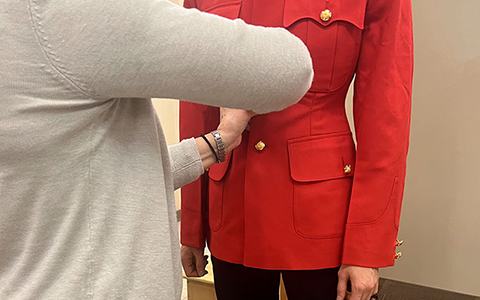Week 11: Dress for all occasions
Shooting in different uniforms

The weather in Canada varies from coast to coast to coast and with each season. Police officers have to prepare for all conditions.
As Depot is in Saskatchewan, cadets experience a variety of weather conditions. An important element of training is to practise using a firearm in all variations of dress. Handling a firearm will feel different if you are wearing a parka and gloves or a short sleeve shirt.
Drawing and shooting a firearm while wearing winter gloves and a parka is a reality of policing in Canada I didn't consider.
Domestic violence
Police are often the first contact for calls of intimate partner violence and family conflict.
In week 11, cadets take part in a scenario in which they attend a domestic violence call for service. Actors take on the roles of the victim and suspect.
These scenarios provide cadets with the opportunity to apply their knowledge and skills. Facilitators provide them with feedback on their ability to resolve the situation.
Types of weapon offenses
Throughout training, cadets continue to study the Criminal Code. This week they learn about various weapon-related crimes and what makes up each offence.
It is important for police officers to understand these different types of offences.
Search warrants
Courts issue legal documents called search warrants to allow police to search a specific location for evidence.
Cadets learn the legal requirements and process to get one, as well as when they can act without a search warrant.
Cadets write mock search warrants to show their understanding of the process.
Kit Issue #3

In their final kit issue, cadets receive their "walking out" uniform. This includes the famous scarlet tunic, dress pants or long skirt, and black shoes.
Cadets wear this uniform to their graduation banquet and any future formal events.
I was overwhelmed with emotion the day I went for my fitting. I couldn't believe I was finally wearing the red serge - something I have been looking forward to my entire life. I was so proud for making it this far.
Cultural aspects of the uniform

The RCMP uniform has evolved throughout the years. Some of these changes allow us to better reflect our diverse workforce.
Headwear options have expanded beyond the standard forage cap and Stetson. Today, navy or tan hijabs and turbans can be worn to match the ceremonial and operational dress.
At ceremonial events you may also see Eagle feathers or a Métis sash worn with the Red Serge.
As a Sikh, I felt proud to see men in the RCMP wearing a turban with their red serge.
Highlights
Other agency uniforms
Some Indigenous police agencies send their cadets to train alongside RCMP cadets. They are like any other member of the troop, but with one visible difference: they wear their own uniforms.
During graduation week, these cadets raise their agency's flag outside the Drill Hall.
Upon graduation, they get the same certification as their RCMP troopmates. Whenever possible, a member of their agency presents their badge.
I was surprised and delighted to see cadets in other troops from Indigenous police forces. It was great to see these cadets represent.
Did you know?
All the cadets' boots must match. A troop decides together what shade they will polish their boots
Did you know?
Who is the Sam Browne belt named after? General Sir Samuel Browne, a 19th-century British Indian Army cavalry officer.
A rider typically uses their left hand to steady their scabbard when drawing their sword. Browne had lost his left arm, making this much more difficult. Instead, he added a second belt over his right shoulder. This held his scabbard steady, allowing him to access his equipment one-handed.
Today, the Sam Browne belt is part of the RCMP ceremonial uniform.
- Date modified: